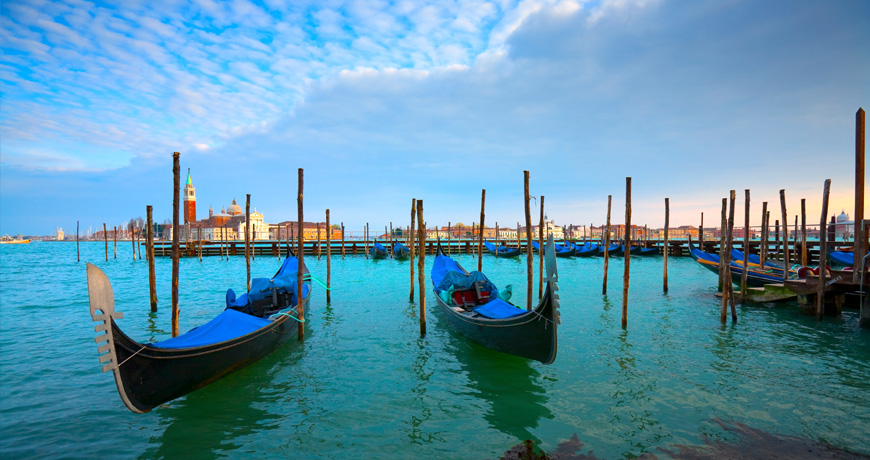Touristic information: Venezia

Venice, the queen of the Venetian Lagoon from which the Venetians dominated the Adriatic for centuries, creating the most splendid of Marine Republics, leaves you stupefied for the diversity of its beauty, so much so that you wonder whether there is a single place in the city that is not worth seeing. Distributed over 18 little islands, the city maintains the old districts it always had, the sestieri: Cannaregio, S. Marco, Castello, S. Croce, S. Paolo and Dorsoduro, and includes the islands of S. Giorgio Maggiore and Giudecca. Throughout, you breathe in the unique atmosphere of a city which was a bridge between the East and the West: all evidence of unequalled cosmopolitanism and commercial wealth, transmitted by Venetians into public works and private houses. It is the case of the basilica di S. Marco, built in the 9th century, its cupola architecture and mosaic decorations inspired by the church of the SS. Apostoli in Constantinople, as is certainly the case with all Venetian-gothic monuments, including the Palazzo dei dogi which, with the Basilica, dominates Piazza S. Marco.
Venice's splendour lasted throughout the centuries, giving rise to immortal works of art: from the Renaissance grace of the Rialto Bridge, to the classic 18th century beauty of the Chiesa della Salute, to the neoclassic equilibrium of the Teatro La Fenice, one of Italy's most prestigious, destroyed by a fire in 1996. Countless museums and galleries (among which it is worth mentioning at least the Gallerie dell'Accademia and the Museo Correr) preserve an unrivalled artistic heritage.
For the unhurried tourist, it is important to remember that "Venice" is not just the little island on which San Marco's bell tower stands triumphantly, but it is also the Lido, Murano, Burano.
In Murano you can visit the glass factories which make Venetian glass art one of the world's most prestigious. In Burano, as well as searching for the renown lace, you must see some of the most ancient churches in the Lagoon, Santa Maria and San Donato, and their splendid mosaics. At the Lido, you can relax strolling along the elegant tree-lined avenues, gazing up at splendid hotels, until you reach the beach's long strip of sand, equipped in the summer with elegant white marquees that protect bathers from the sun.
For those seeking hidden corners in the Serenissima, a few paces away from Piazza San Marcothere's the "squero" of Dorsoduro, basically the Gondola factories: three of these, at the corner of rio di San Trovaso with rio di Ognissanti, are the most impressive. In Cannareggio, in Corte Sconta del Milion, you can see Marco Polo's house. The great traveller appears to have lived until his death, in 1324, in a building destroyed by fire in 1596.
Venice hosts many events throughout the year, attracting visitors from all over the world.
Certainly an international attraction is the Carnival.
Celebrated from the times of the Republic of Venice, the Carnival created a cheerful climate where noblemen and simple folk mingled, protected by the anonymity of the mask. Even today, in the ten days before Ash Wednesday, parades of multicoloured masks cross the city, masked parties are organised in the palaces and artists and jugglers entertain the crowds.
After the winter fun of the Carnival, an all-Venetian and less "touristy" festival happens during the summer. That is the Festa del Redentore, celebrated every year on the third weekend of July: in a rite that has been repeated for the last 400 years, hundreds of boats gather in the basin of San Marco awaiting midnight's fireworks in honour of the Redeemer, while a bridge of floating platforms unites the city to the Giudecca.
At the beginning of September, the Mostra del Cinema calls to the Lido International cinema stars and lovers, for a week of previews that culminates with the award of a Leone d'oro to the best film.
Autumn also offers the Biennale d'arte, which hosts in its halls the newest works of contemporary world and European art.
